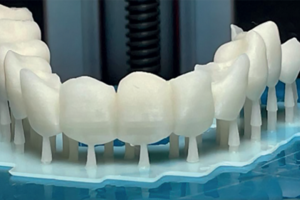RESUMO
O bruxismo é definido como o hábito de ranger, apertar, imobilizar ou projetar a mandíbula, com graves consequências ao sistema estomatognático, como desgaste dentário, dores musculares e articulares. Pode ser classificado em bruxismo do sono (BV) e bruxismo de vigília (BV). Sua etiologia é multifatorial e, para ser controlado, é necessária uma abordagem multidisciplinar. As placas oclusais são utilizadas como terapia de primeira linha para o bruxismo do sono, sendo tradicionalmente confeccionada com acrílico prensado. Com a introdução das ferramentas baseadas na era digital, as placas agora podem ser confeccionadas por sistemas assistidos por manufatura (computer aided design/computer aided manufacturing – CAD/ CAM), seja através de impressões ou por meio de fresagem. O objetivo deste trabalho foi descrever a confecção de uma placa oclusal pelo método híbrido, relatando a sua importância para o controle do bruxismo do sono e consequente alívio dos sinais e sintomas das desordens temporomandibulares.
Palavras-chave – Bruxismo; Placas oclusais; CAD/CAM; Impressão 3D.
ABSTRACT
Bruxism is defined as the habit of grinding, clenching, immobilizing, or projecting the jaw, with serious consequences to the stomatognathic system, such as dental wear, muscle, and articular pain. It is classified as sleep bruxism (SD) and wakefulness bruxism (WB). Its aetiology is multifactorial, and multidisciplinary approaches are required for its control. Occlusal splints are used as first-line therapy for sleep bruxism and are traditionally made of pressed acrylic. With the introduction of digitally based tools, these can now be made by computer aided design/computer aided manufacturing (CAD/CAM) systems, either by impressions or by milling. The aim of this paper is to describe the manufacture of an occlusal splint using the hybrid method and to report on its importance for the control of sleep bruxism and consequent relief of signs and symptoms of temporomandibular disorders.
Key words – Bruxism; Occlusal splints; CAD/CAM; 3D printing.
Referências
- Manfredini D, Serra-Negra J, Carboncini F, Lobbezoo F. Current concepts of bruxism. Int J Prosthodont 2017;30(5):437-8.
- Shetty S, Pitti V, Babu CLS, Kumar GPS, Deepthi BC. Bruxism: a literature review. J Indian Prosthodont Soc 2010;10(3):141-8.
- Sierwald I, John MT, Schierz O, Hirsch C, Sagheri D, Jost-Brinkmann PG et al. Association of temporomandibular disorder pain with awake and sleep bruxism in adults. J Orofac Orthop 2015;76(4):305-17.
- Lobbezoo F, Ahlberg J, Glaros AG, Kato T, Koyano K, Lavigne GJ et al. Bruxism defined and graded: an international consensus. J Oral Rehabil 2013;40(1):2-4.
- Valle RT, Grossmann E. Disfunções temporomandibulares – novas perspectivas (1a ). Ribeirão Preto: Livraria e Editora Tota LTDA, 2019. p.328-38.
- Kaya DI, Ataoglu H. Botulinum toxin treatment of temporomandibular joint pain in patients with bruxism: a prospective and randomized clinical study. Niger J Clin Pract 2021;24(3):412-7.
- Okeson J. Tratamento das desordens temporomandibulares e oclusão (7a). Rio de Janeiro: Elsevier Editora Ltda, 2013. p.526.
- Salm M, Paloheimo KS, Tuomi J, Ingman T, Mäkitie A. A digital process for additive manufacturing of occlusal splints: a clinical pilot study. J R Soc Interface 2013;10(84):20130203.
- Wang SM, Li Z, Wang GB, Ye HQ, Liu YS, Tong D et al. Preliminary clinical application of complete digital workflow of design and manufacturing occlusal splint for sleep bruxism. Beijing Da Xue Xue Bao 2019;51(1):105-10.
- Kardeş E, Kardeş S. Google searches for bruxism, teeth grinding, and teeth clenching during the COVID-19 pandemic. J Orofac Orthop 2022;83(6):1-6.
- Lobbezoo F, Ahlberg J, Raphael KG, Wetselaar P, Glaros AG, Kato T et al. International consensus on the assessment of bruxism: report of a work in progress. J Oral Rehabil 2018;45(11):837-44.
- Matsumoto H, Tsukiyama Y, Kuwatsuru R, Koyano K. The effect of intermittent use of occlusal splint devices on sleep bruxism: a 4-week observation with a portable electromyographic recording device. J Oral Rehabil 2015;42(4):251-8.
- Wolowski A, Schneider HJ, Eger T. Dental disorders with a psychosocial background. Bundesgesundheitsblatt Gesundheitsforschung Gesundheitsschutz 2021;64(8):951-8.
- Wolowski A, Schneider H-J, Eger T. Zahnmedizinische Beschwerdebilder mit psychosozialem Hintergrund. Bundesgesundheitsblatt Gesundheitsforsch Gesundheitsschutz 2021;64(8):951-8.
- Koyano K, Tsukiyama Y, Ichiki R, Kuwata T. Assessment of bruxism in the clinic. J Oral Rehabil 2008;35(7):495-508.
- Amorim CF, Paes FJV, de Faria Junior NS, de Oliveira LVF, Politti F. Electromyographic analysis of masseter and anterior temporalis muscle in sleep bruxers after occlusal splint wearing. J Bodyw Mov Ther 2012;16(2):199-203.
- Rosar JV, Barbosa TS, Dias IOV, Kobayashi FY, Costa YM, Gavião MBD et al. Effect of interocclusal appliance on bite force, sleep quality, salivary cortisol levels and signs and symptoms of temporomandibular dysfunction in adults with sleep bruxism. Arch Oral Biol 2017;82:62-70.
- Barbosa JS, Silva JM, Raposo M. Placa oclusal miorrelaxante como terapia para prevenção aos agravos do bruxismo: relato de caso clínico 2019;7-8.
- Marcel R, Reinhard H, Andreas K. Accuracy of CAD/CAM-fabricated bite splints: milling vs 3D printing. Clin Oral Investig 2020;24(12):4607-15.
- Abdallah H. Hard occlusal splints made by vaccum machine versus 3d digital printed splints in treatment of muscle pain (electromyogram). Egypt Dent J 2018;64(2):443-56.
- de Oliveira DC. Avaliação do tempo clínico, laboratorial e do conforto de placas oclusais convencionais e digitais: um ensaio clínico piloto [On-line]. Disponível em <https://repositorio.ufrn.br/handle/123456789/32197>. Acesso em: 23-3-2022.





